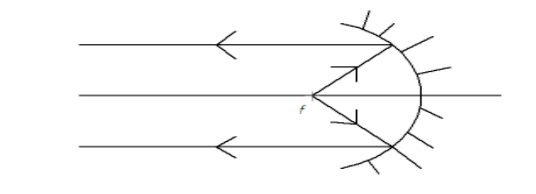
When the object is at focus of a concave mirror, the image is formed at
A. focus
B. center of curvature
C. within focus
D. infinity
Answer
219k+ views
Hint A hollow sphere is cut into fragments and the outside surface of the cut part is highlighted, then it becomes a mirror with its internal surface as the reflecting surface. This kind of mirror is recognized as a concave mirror. Light meets at a point when it strikes and reflects back from the reflecting surface of the concave mirror. Therefore, it is also known as a converging mirror
Complete Step by step solution

When a ray passes through focus and incident on a concave mirror then it will travel parallel to the principal axis after reflection. Hence the image is formed at infinity.
Additional Information
A concave mirror also known as a converging mirror has a reflecting surface that is away from the incident light.
These mirrors reflect light inside into one focal point. These are used to focus the light.
Note
When the parallel rays of light pass through a concave lens to the principal axis, it diverges from its focal point and refracts the light rays. Due to this purpose, it is called the Concave or Diverging lens. An incident light ray parallel to the principal axis of a concave lens, passes through it and diverges. When generalized, it appears to pass through the focus
Every ray of light that is incident on a shiny flat surface bounces back. This can be proved by forming the image of an object in a flat mirror. Since ${\theta _r} = {\theta _i}$; therefore, The point is called the "virtual focal point" of the convex mirror. Ray 2 passes through F and travels parallel to the main axis after reflection.
Complete Step by step solution

When a ray passes through focus and incident on a concave mirror then it will travel parallel to the principal axis after reflection. Hence the image is formed at infinity.
Additional Information
A concave mirror also known as a converging mirror has a reflecting surface that is away from the incident light.
These mirrors reflect light inside into one focal point. These are used to focus the light.
Note
When the parallel rays of light pass through a concave lens to the principal axis, it diverges from its focal point and refracts the light rays. Due to this purpose, it is called the Concave or Diverging lens. An incident light ray parallel to the principal axis of a concave lens, passes through it and diverges. When generalized, it appears to pass through the focus
Every ray of light that is incident on a shiny flat surface bounces back. This can be proved by forming the image of an object in a flat mirror. Since ${\theta _r} = {\theta _i}$; therefore, The point is called the "virtual focal point" of the convex mirror. Ray 2 passes through F and travels parallel to the main axis after reflection.
Recently Updated Pages
A square frame of side 10 cm and a long straight wire class 12 physics JEE_Main

The work done in slowly moving an electron of charge class 12 physics JEE_Main

Two identical charged spheres suspended from a common class 12 physics JEE_Main

According to Bohrs theory the timeaveraged magnetic class 12 physics JEE_Main

ill in the blanks Pure tungsten has A Low resistivity class 12 physics JEE_Main

The value of the resistor RS needed in the DC voltage class 12 physics JEE_Main

Trending doubts
JEE Main 2026: Application Form Open, Exam Dates, Syllabus, Eligibility & Question Papers

Understanding Uniform Acceleration in Physics

Derivation of Equation of Trajectory Explained for Students

Hybridisation in Chemistry – Concept, Types & Applications

Understanding the Angle of Deviation in a Prism

Understanding Collisions: Types and Examples for Students

Other Pages
JEE Advanced Marks vs Ranks 2025: Understanding Category-wise Qualifying Marks and Previous Year Cut-offs

Understanding Atomic Structure for Beginners

How to Convert a Galvanometer into an Ammeter or Voltmeter

Understanding Centrifugal Force in Physics

JEE Main Marking Scheme 2026- Paper-Wise Marks Distribution and Negative Marking Details

Degree of Dissociation: Meaning, Formula, Calculation & Uses




